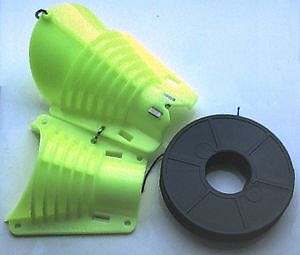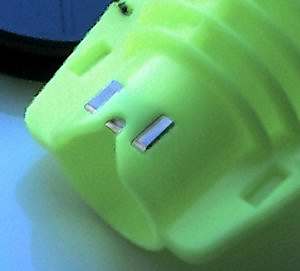Before I had heard of the Angler’s Line Cutter I was hitting more snagsthan a blind man casting into a bramble thicket, often losing farmore than my hook length, and I thought that there had to be a betterway of retrieving your snagged line than for instance dipping the rodor pole and praying to the god of fishing as you tightened the clutchand wound in.

Then I saw a scrawny little mention for this ‘thing’ in an anglingweekly, which claimed to be the end of these problems, and I went offto their website thinking ‘Gimmick’. Once there though I wasimpressed enough by their spiel to want to give the thing a go, itclaimed to be able to aid the retrieval of 90% of your snagged tacklefrom either rod or pole, even floats and other tackle items up to acertain size.
The idea is this: You put this unit over your rod top and line,(it breaks into two halves) with the braid it comes with attached toone end. Then when you tilt your rod up, it slides down the line towhere you are snagged and with a tug on the braid it cuts your lineat that point. There was even a demo on the site as to how it workedand still thinking ‘gimmicky gadget’ but amused by the notion, Iplagued them until they gave me one to try.
As promised it arrived a few days later and I have to admit myfirst impressions didn’t amount to much. I missed the fact that theinstructions were on the inside of the top packaging label, which Ihad thrown in the bin. It also seemed too hard a plastic to belong-lasting in my first view and I had visions of the clips thatheld the thing together breaking off after 2 or 3 uses. So after aquick look at the heavy braid that came with it, and wondering if itthat would be any use to me, I threw the whole thing in my tackle boxstill thinking ‘gimmick’, where I subsequently forgot about it.(Whole novels could probably be written about the things that lurk inthere).

Two days later I was caught up very badly in an oak stump at thebottom of a 30ft lake. I was using a fairly hefty braid that felt onthe initial tug as though I would be likely to pull up the whole treeas snap my line at the best point. So in desperation I grabbed theyellow/green devil and two of us made a pitiful attempt at usingit.
Now it has to be said that in retrospect it wasn’t the linecutters fault, or its design. Instead it was a misunderstanding ofthe instructions (which I had saved from the bin in the end), mixedwith poor communication of both the parties involved. Firstly Ipresumed you had to ‘push release’ the two clips that hold the cuttertogether, and we both struggled for quite a few minutes to get themto do this, having to resort to my pliers, leading me to think: ‘Andhow is some poor old bugger with dodgy hands gonna manage this?’ Nextwe put it over the rod and it sailed down the line a bit, whereuponmy instruction to pull resorted in the pulling of the line to cutrather than the intended lift of the rod to allow it to sail downfurther. Whereupon we managed to dump a good 30 yards of 7lb braidand a decent feeder in the lake. Not an auspicious start for thedevice that was supposed to aid me in leaving less line in thewater.
Needless to say the thing sat in my box for some time untouched,partly because my not trusting its usage and also because I went foran amazing length of time without hitting a snag. Even my naturalability to attach my tackle to the nearest tree or bush in a 200-yardradius seemed to have eased, (anyone who knows me would be amazed atthis fact alone).
The next time we remembered the Line Cutter was some five weekslater when one of us got caught up whilst fishing a heavy elasticisedpole. Now anyone who has had this misfortune will know just howdangerous this can be: the wrong pull and either the upper sectionscan come apart and be dumped into the depths (an expensive loss), or,as I have seen myself, the hook length can snap, which combined withthe snap back of the elastic, results in a high velocity bristlefloat coming at you faster than Carl Foggerty on the home straight,(which can be potentially lethal). So in a desperate attempt to saveourselves from either we tried the thing again and it worked atreat.

I dropped it over the 4th section, lifted it and watched it saildown pole and line, then I felt it hit where I was snagged, and witha pull on the retaining braid, it cut the line, and ‘hey presto!’line float and even olivette all came back together with very littleline lost. I was much more impressed by this and looked again at thewhole thing with a fresh eye, I even popped back to their web-sitethe next time I was on and looked again at their demo’s to see whatwe had done wrong with the first attempt.
Here I noticed I had missed one important point to do with thoseblasted clips: You didn’t have to struggle to release them the thingjust snapped open with a sharp tug: even my toddling nephew couldprobably manage that! With this in mind, and more confident knowledgeas to it’s correct use, the next time it was needed on afeeder-fishing trip, it worked the way it was supposed to and evenretrieved my swim feeder (a slim one admittedly, but that is morethan I sometimes get back).
I wont pretend it isn’t a little fiddly and it is definitely aneasier task with two people, but it can do what it says on thepacket, and in particular with heavier lines where dipping andtugging feels as though it could take the entire Welsh tug of warteam to snap that hook length, it could be a great help. It also hasa feature for attaching an additional weight, so as to aid sending itdown your line and/or steady it on windy days.
As for retrieval of snagged pole lines, it is definitely a muchsafer method of retrieval than I have come across before, and forthis alone I would recommend carrying one in your tackle box.
They don’t appear to be available in tackle shops at present,(something I hope will be changed soon) but you can see/order oneyourself via www.anglerslinecutter.co.uk
See Forum link below to win an Angler’s Linecutter.













